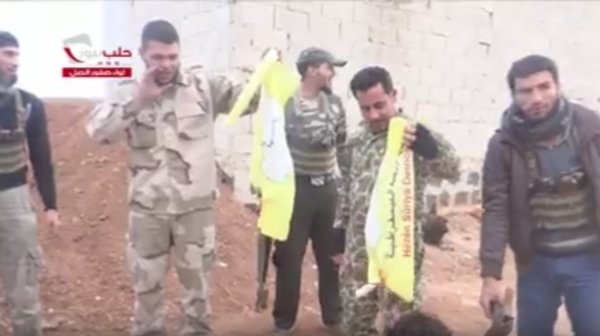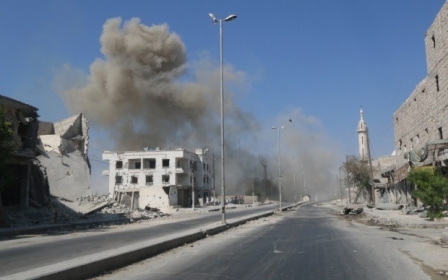YPG, allies clash with Syrian opposition groups in Aleppo

Fierce fighting has broken out in Aleppo between the Syrian Democratic Forces (SDF) - a coalition of Free Syrian Army (FSA) groups and the (Kurdish) People’s Protection Units (YPG) - and other Syrian opposition groups including Ahrar al-Sham, the al-Qaeda affiliated Al-Nusra Front and other FSA factions.
Following the clashes, fighters from the Fatah Halab coalition - which includes Ahrar al-Sham and FSA brigades - reportedly took control of the villages of Keshtar and Tanab from SDF forces on Sunday.
Sources on Twitter also claimed that scores of opposition fighters had been killed as they continued to attempt to retake the SDF-controlled village of Maryamin.
Video released on YouTube showed fighters in Keshtar from Liwa Suqour al Jabal - a group reportedly vetted by the CIA - burning SDF flags while chanting “Allahu Akbar!”
Clashes were continuing in Aleppo around the Sheikh Maqsud area on Sunday.
Sheikh Maqsud, a majority-Kurdish district of Aleppo, has been a flashpoint between the YPG and other opposition groups for some time.
Though there had been a tentative power sharing agreement in the past, the area has recently come under bombardment from Nusra and other rebel groups.
On Friday, a statement released by Liwa Ahrar Suriya, an Aleppo-based rebel group, warned that Sheikh Maqsud had become a “military zone” and referred to the YPG as the PKK, the acronym of the YPG's sister party, the Kurdistan Workers' Party, in Turkey.
"The PKK is cooperating with Russia against rebels, trying to cut the supply line to Aleppo," read the statement, referring to the YPG's support for Russian airstrikes against "jihadist" groups.
Yasser Abdul Raheem, a leader of Fatah Halab, also claimed that forces from Jaish al-Thuwwar - an FSA faction of the SDF - had killed 20 civilians in Tanab on Saturday.
However, the Kurdish Hawar news agency claimed instead that the killings had been carried out by Nusra and Ahrar al-Sham.
The fighting is likely to be a further headache for the US, which has been involved in training and supporting groups on both sides of the clashes.
Since the beginning of Syria’s civil war, the YPG have been at odds with many rebel factions for both tactical and ideological reasons.
In particular, the highly secular YPG has been hostile to the presence of Islamist groups in the opposition, who it believes will not be supportive of Kurdish rights should they come to power.
In a 2011 interview with KurdWatch, Salih Muslim Muhammed, the co-chairman of the YPG’s political wing, the Democratic Union Party (PYD), said he could not imagine working with factions in the opposition linked to the Muslim Brotherhood.
“The Muslim Brotherhood does not acknowledge the existence of the Kurds,” he said. “They have signed an agreement with Turkey that they will deny the existence of the Kurds if they come to power in Syria."
For their part, many Syrian opposition groups have seen the YPG as too accommodating to the government of Syrian President Bashar al-Assad.
YPG figures have repeatedly asserted that, though they are fundamentally opposed to the Assad government - which has suppressed Kurdish rights for decades - they view Salafist jihadist groups such as the Islamic State group and Al-Nusra Front as their main priority.
Alliances have been further frustrated by Turkish support for rebel groups and the breakdown of the long-held ceasefire between the Turkish state and the YPG’s sister party, the PKK.
Though the YPG has built support in Kurdish-majority areas of Syria, it has often been greeted with hostility in areas with a high Arab population, many of whom mistrust the YPG’s perceived Kurdish nationalist aspirations.
Religious conservatives have also rankled at the YPG’s Marxist and anarchist-inspired philosophy, which has been labelled atheistic.
A video of a protest in the SDF-controlled village of Maryamin on Saturday appears to show demonstrators calling for the “PKK” to leave and praising Ahrar al-Sham:
Middle East Eye propose une couverture et une analyse indépendantes et incomparables du Moyen-Orient, de l’Afrique du Nord et d’autres régions du monde. Pour en savoir plus sur la reprise de ce contenu et les frais qui s’appliquent, veuillez remplir ce formulaire [en anglais]. Pour en savoir plus sur MEE, cliquez ici [en anglais].




